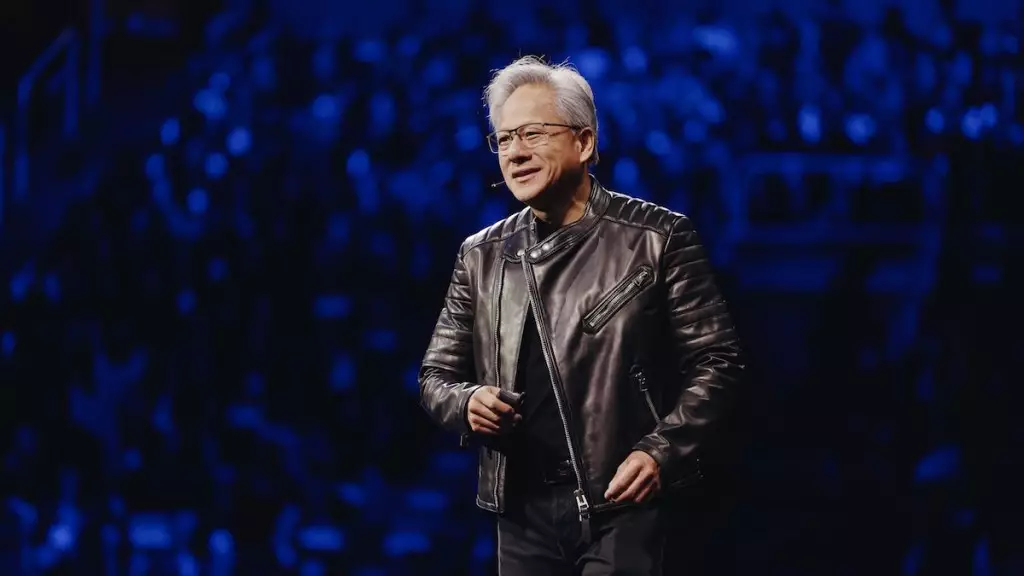The landscape of artificial intelligence is undergoing an extraordinary transformation, propelled by advancements that are redefining what we perceive as achievable within this technological domain. As industry pioneer Jensen Huang articulated during his keynote at the recent GTC conference, there’s a discernible shift from mere AI training to full-scale production inference. This transition signifies not just an evolution in how we approach AI technology, but also highlights the staggering demand for computational power. With AI factories gearing up to handle millions of user queries, the projected economic impact of AI is forecast to soar to an unprecedented $1 trillion.
Huang’s comments underscore a critical reality: the infrastructure to support this technological leap is not merely a luxury but a necessity. The conventional data center is evolving into a fully-fledged AI factory, equipped to churn out solutions at a speed and efficiency previously thought impossible. This paradigm shift is set against the backdrop of escalating compute requirements, pushing data centers to innovate or become obsolete.
The Revolutionary Blackwell Ultra AI Platform
At the heart of NVIDIA’s recent announcements lies the formidable Blackwell AI platform. By delivering an eye-popping 40x performance improvement over its predecessor, Hopper, Blackwell is not just an incremental upgrade; it represents a metamorphosis. This architectural leap is fundamental in enhancing the training and inference processes of AI models, allowing for broader application capabilities and operational scalability. The forthcoming Blackwell Ultra, anticipated in late 2025, promises to further this trajectory with a design tailored to support next-generation AI models, ensuring that enterprises are equipped to navigate the escalating complexities of AI utilization.
The implications of these advancements extend well beyond mere performance metrics. Companies aiming to harness AI’s potential must not only focus on hardware but on developing an entire ecosystem that fosters innovation and efficiency. NVIDIA’s commitment to yearly updates in AI architecture exemplifies a forward-thinking philosophy that recognizes the fast-paced nature of technological change.
Strategic Collaborations and Infrastructure Innovations
NVIDIA’s vision does not stop at hardware. Innovations such as the Vera Rubin platform, expected to be released in late 2026, aim to dramatically enhance the performance metrics of AI data centers. With improved data transfer speeds between chips, their efforts focus on optimizing the interconnectivity that is vital for large-scale AI operations. In this context, NVIDIA is not just participating in the AI race; it is effectively redefining the rules of engagement.
Furthermore, advancements in networking, such as the Spectrum-X and Quantum-X platforms, signify a crucial shift towards energy efficiency in AI infrastructures. By facilitating communication among millions of GPUs with reduced energy expenditures, NVIDIA is facilitating a more sustainable approach to AI technology deployment. This is increasingly important as businesses strive to reconcile the growing computational power needs with environmental considerations.
AI-Powered Robotics: A $50 Trillion Opportunity
The broader implications of AI advancements cannot be overlooked, especially as we consider the transformative potential of AI-powered robotics. Huang estimates that this facet of AI could unlock a staggering $50 trillion in economic opportunity across diverse industries—ranging from healthcare to logistics and beyond. Here, NVIDIA’s Isaac and Cosmos platforms are trailblazers, paving the way for robotics that could fundamentally alter operational methodologies across sectors.
The collaboration with Google DeepMind and Disney to develop advanced physics engines exemplifies the multifaceted approach to AI, enabling robots to handle complex tasks with unmatched precision. This level of innovation is not merely about automation; it is about creating systems capable of sophisticated reasoning and adaptability, further integrating AI into our daily lives and industries.
Future Perspectives: A Commitment to Excellence
NVIDIA’s trajectory is marked by an unwavering commitment to not just participate but to lead the development of AI technologies. This is evident in initiatives like their open-source Dynamo software designed to accelerate multi-step reasoning capabilities, thus fostering an environment of rapid innovation. Beyond hardware and software, the establishment of the NVIDIA Accelerated Quantum Research Center indicates a clear intent to invest in the future of AI and its complementary technologies, such as quantum computing, ensuring that NVIDIA remains at the cutting edge of this fast-evolving landscape.
The evolution of AI is an omnipresent force that promises to shape our world in monumental ways. NVIDIA’s strategic initiatives position it not just as a participant within this revolution but as a vanguard leading the charge. The possibilities are truly limitless, and with each advancement, the potential for real-world impact intensifies. As we look forward, it is clear that the journey into an AI-dominated future holds extraordinary promise, beckoning us to embrace the evolution wholeheartedly.

